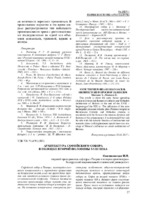Архитектура Софийского собора в Полоцке второй половины XVIII века
Another Title
The architecture of st. Sophia cathedral in Polotsk in XVIII century
Bibliographic entry
Ожешковская, И. Н. Архитектура Софийского собора в Полоцке второй половины XVIII века = The architecture of st. Sophia cathedral in Polotsk in XVIII century / И. Н. Ожешковская // Архитектура : сборник научных трудов. – 2017. – Вып. 10. – С. 27-33.
Abstract
Софийский собор в Полоцке, являющийся символом независимости и зарождения православия на белорусских землях, в то же время более двухсот лет находился в статусе главного храма греко-католической конфессии. Статья посвящена изучению архитектуры собора периода унии, являющегося самым малоизученным в истории храма. На основании исторических материалов рассмотрены особенности объемно-планировочной структуры мужского и женского монастырей базилианского ордена, сформированных вокруг собора св. Софии во второй половине XVIII в. – первой половине XIX в. Выявлен факт существования оптической живописи на главном фасаде храма. Кроме этого исследованию подвергся интерьер собора, который определил его формирование на основе синтеза восточной церкви, соединенной с римской. Реконструкция собора и появление в нем монументальных алтарей и иконостаса была проведена при содействии митрополита Флориана Гребницкого, идеологическая политика которого была направлена на демонстрацию могущества и прочной позиции греко-католической конфессии на Беларуси. Великолепие и богатство Софийского собора были этому подтверждением.
Abstract in another language
The famous St. Sophia Cathedral in Polotsk, which is a symbol of independence and dawn of Orthodoxy on Belarusian lands, at the same time more than two hundred years had the status of the main Church of the Greek Catholic denomination. The article is devoted to the study of Cathedral architecture during the period of the Union, which is the most poorly known in the history of the temple. On the basis of historical materials the features of spaceplanning structure of male and female monasteries of the Basilian order, formed around the Cathedral of St. Sophia in the second half of XVIII – first half XIX century were reseached in the article. The existence of optical painting on the main facade of the temple was discovered that makes a significant contribution to the study of architecture of Belarus. In addition, there was a study of the interior of the Cathedral, which identified its formation on the basis of a synthesis of the Eastern Church united with the Roman one. The reconstruction of the Cathedral and the appearance in it of the monumental altars and iconostasis were conducted with the assistance of the Metropolitan Florian Grebnitskiy, whose ideological policy was aimed to demonstrate the power and the strong position of Greek-Catholic confession in Belarus. The splendor and richness of the St. Sophia Cathedral were the proof of it.

